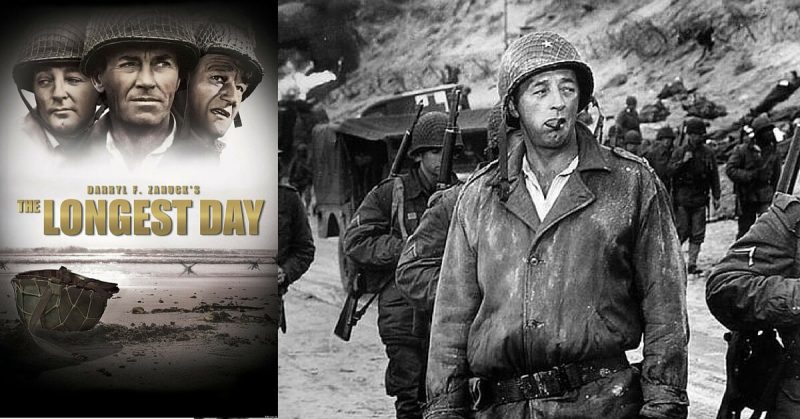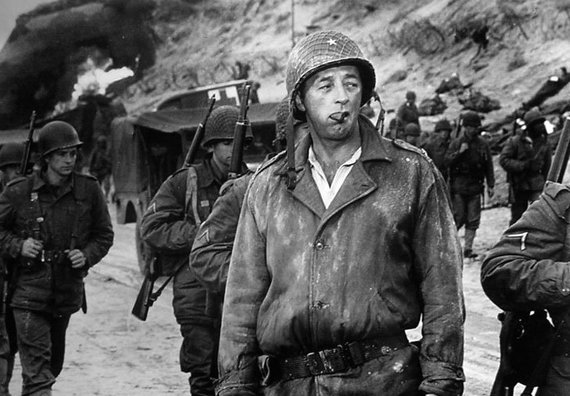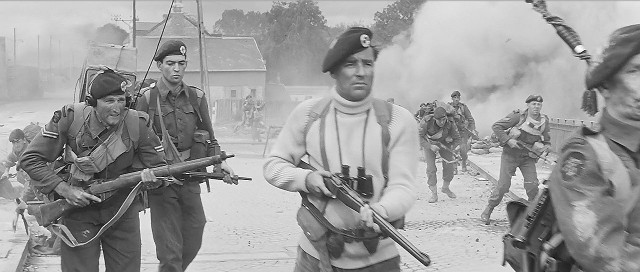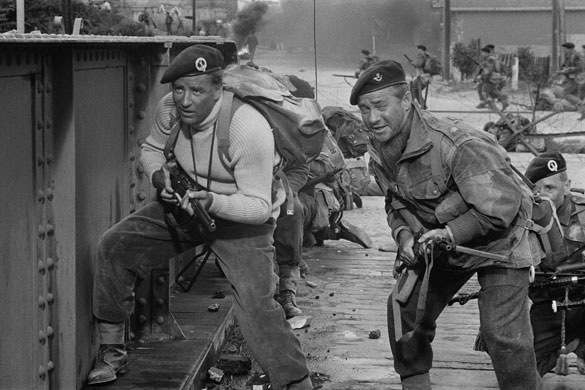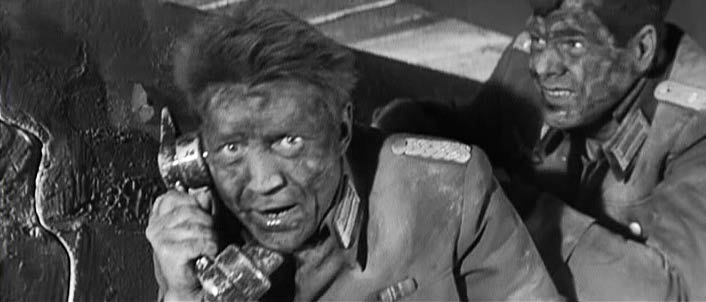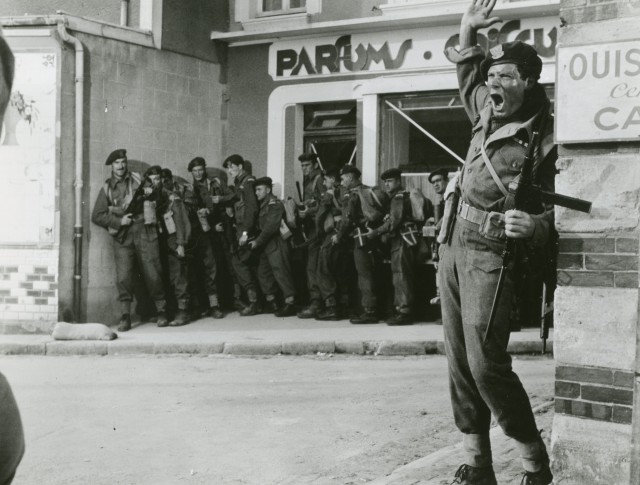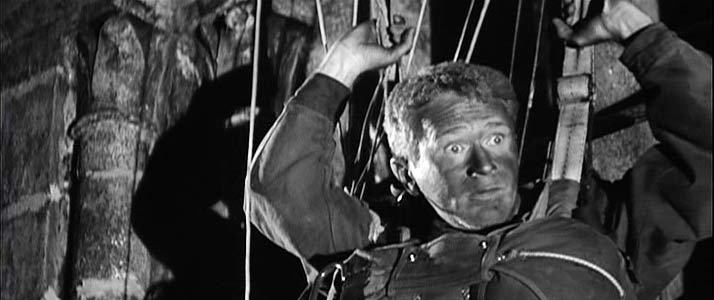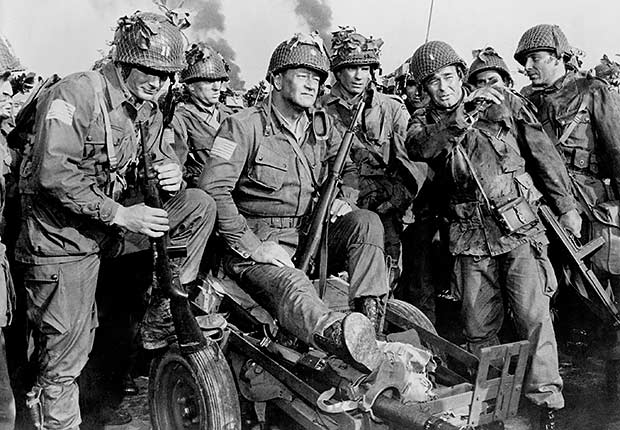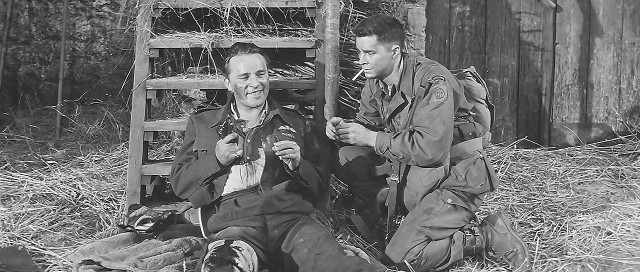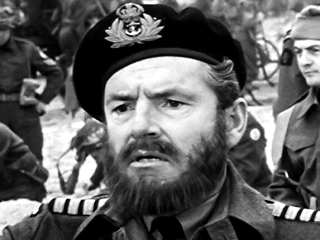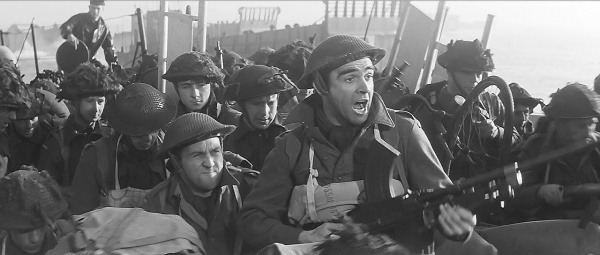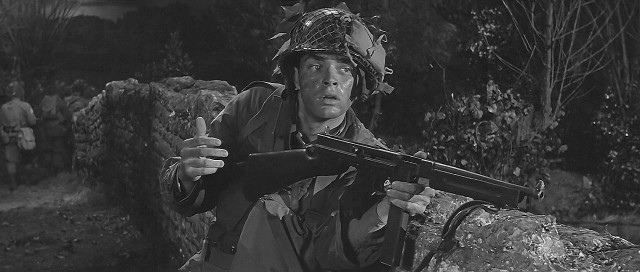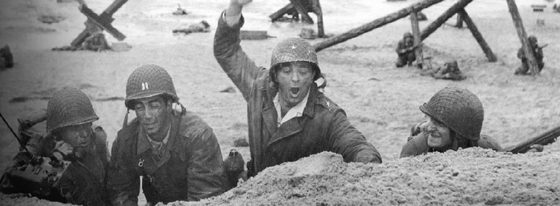The Longest Day, which was made in black and white, features a large ensemble cast including John Wayne, Kenneth More,Richard Todd, Robert Mitchum, Richard Burton, Sean Connery, Henry Fonda, Red Buttons, Peter Lawford, Eddie Albert, Jeffrey Hunter, Stuart Whitman, Tom Tryon, Rod Steiger, Leo Genn, Gert Fröbe, Irina Demick, Bourvil, Curt Jürgens, Robert Wagner, Paul Anka and Arletty.
Many of these actors played roles that were virtually cameo appearances and several cast members such as Fonda, Genn, More, Steiger and Todd saw action as servicemen during the war, with Todd being among the first British officers to land in Normandy in Operation Overlord and participated in the assault on Pegasus Bridge. So just for some fun here are some of the movie mistakes – we expect you spotted most of them anyway 🙂
When the ships are about to begin bombarding the beaches you see a group of planes fly by the camera these are Douglas Sky Raiders which did not see service until the late 1940s.
The currency notes in Schultz’s winnings are of a later issue than was in circulation in 1944.
Features LCM-8s, which weren’t built until 1954.
German General Max Pemsel says: “Wir haben starke RADAR-störungen” (We have strong radar interference). The word “radar” was not used, perhaps even not known in Germany in 1944. They used a somewhat similar system, but called it “Funkmeßgeräte” (radio measuring equipment).
General Gavin is wearing a Senior Parachutist badge in 1944.The Parachutist Badge was formally approved on 10 March 1941. The senior and master parachutists badges were authorized by Headquarters, Department of the Army in 1949 and were announced by Change 4, Army Regulation 600-70, dated 24 January 1950.
During the go/no go sequence, a jet can be heard flying overhead as the naval representative is speaking.
During a very early scene in France, the back end of a Citroen 2CV can be seen parked at the side of the street as the German soldiers march down it.
When FO David Campbell is sitting, drinking a beer, we see someone standing and playing the piano in the background. The music heard is a slow rendition of the main theme of the movie, but the player is playing several notes with his right hand at the time only one note is heard in the soundtrack.
When Lovat’s commandos land, the piper is playing “Black Bear,” however, when we see the piper he is still trying to inflate the bagpipe using one hand.
During the British glider assault on the bridge, the same glider lands three times.
When the coded radio messages are read out in French, the awaited second line of the poem by Verlaine, “Blesse mon coeur d’une langueur monotone” (“Wounds my heart with a monotonous languor”) sets the French resistance group in motion. They leave the hiding Allied pilots and take up rifles. The next line heard on the radio before it is shut off is “J’aime les chats siamois” (“I like Siamese cats”) But when the Germans hear and are recording the identical broadcast and hear the line of poetry, the coded message after that is a message heard before the French resistance fighters heard the poetry line: “Daphné à Monique: Il y a le feu à l’agence de voyage. Inutile de s’y rendre.” (“Daphne to Monique: There is a fire at the travel agency. It is no use to get there”).
In the scene where Brig. Gen. Teddy Roosevelt, Jr. (Henry Fonda) lands at Utah Beach he can be clearly seen completely falling in the water as he steps of the landing craft (look for Fonda holding the walking stick), and with clothes completely soaked running up the beach. As the scene continues, he crouches behind a beach obstacle with other officers. As the scene cuts to a closeup, his clothing is suddenly dry.
Early on, three German officers are talking with the coastline as a backdrop. One of the officers moves from right to left on the screen and when he is half way across he disappears (though he is still talking and can be heard). The ocean in the background repeats itself in the first second.
Hans-Christian-Blech-in-The-Longest-Day
When Sal Mineo is shot dead, we hear two shots, but we only hear the bolt action rifle cycled once.
At the beginning of the movie when the German sergeant is taking coffee to the beach gunners we see his horse walking on the supposedly muddy ground, yet the shoes of the horses are not muddy and remain shiny throughout the length of the shot.
When the French first attack the casino, there is barbed wire, but when they run from the hotel to the casino there is none.
When General Cota meets up with General Thompson on the beach, he holds his cigar in his hand. After Cota says, “Think?” there is a quick cut to another angle, and the cigar is back in his mouth. Also, during this cut he uses both hands to take off his helmet, so where did the cigar go during this process?
When the French Commando Commanding Officer, Keiffer goes to get a tank he jumps out a window and is followed by another commando. This man is armed with a STEN Mk V (version with a wooden butt-stock and grips) when he jumps out the window, but when he runs across the street and takes cover with Keiffer before going to the bridge, he is armed with a STEN Mk II (version with steel skeleton butt-stock).
During the shelling at the beginning of the invasion the French farmers mirror breaks and its position shifts. In doing so a stage light is clearly seen.
After General Cota (Robert Mitchum) yells “Get off the beach! Let’s go!” and leads the soldiers up Omaha Beach, the shadow of the camera can be seen in the foreground.
During the final scenes of the movie, when an American general is taken up “Omaha” beach, it’s actually Juno Beach, where the Canadians landed.
The “Rupert” paratrooper dummies dropped on D-Day were not the highly elaborate and lifelike rubber dummies shown in the film. The actual dummies were fabricated from sackcloth or burlap stuffed with straw or sand and were only crude representations of a human figure. They only appeared human from a distance during the descent and were equipped with an explosive charge that burned away the cloth after landing to prevent the immediate discovery of their true nature. A total of 500 dummies, accompanied by a handful SAS troopers, were dropped at four locations. The SAS played recordings of battle noise, set off smoke grenades and used their weapons to further enhance the deception. The whole operation was code-named Operation Titanic.
Colin Maud and his English bulldog, “Winston” are shown spurring “British” Soldiers into advancing up the beach. In fact, the incident took place on the sole “Canadian” Beach, Juno – and Maud’s dog was an “Alsatian” – the (then) politically correct designation for “German Shepherd”.
The American paratroopers are incorrectly shown jumping with a jumpmaster standing in the plane and commanding them to “Go!” “Go!” one at a time. On D-Day, as on all combat jumps, the jumpmaster was always first out the door, with the rest of the paratroopers following immediately behind him, exiting the plane as fast as they could to land as close together as possible.
A compound fracture of the ankle indicates blood and protruding bones, of which Vandervoort’s ankle had none. It also would have been impossible to put any weight on the ankle.
John Wayne in The Longest Day, War Movie Slideshow
The movie shows that the German 155mm guns on Pointe du Hoc were gone when Colonel Rudder’s Rangers got there. It doesn’t show that the Rangers continued inland, found the guns and destroyed them.
In the film, the helmets worn by the 2nd Rangers at Pointe-du-Hoc have no markings. In reality, Ranger helmets had an orange diamond on the back, with a number indicating battalion.
According to Ryan’s book, far from being deafened by the church bell, John Steele said that he didn’t notice it.
During the meeting with LtC Vandervoort, Brig. Gen. James M. Gavin is wearing branch insignia for Infantry. General officers at that time, (and until recently), did not wear branch insignia as they could command any type of unit.
Actors Robert Ryan and John Wayne – both in their mid-50s when the movie was made – were (and looked) some 20 and 30 years too old respectively to be portraying their real-life counterparts. Ryan’s character Brig. General James Gavin was only in his mid-30s at the time of D-Day, and Wayne’s character Lt. Col. Ben Vandervoort was only 27.
David Campbell (Richard Burton) is referred to in the explanatory text as “Flight Officer”. He is actually wearing the shoulder rank insignia of Flying Officer, a low ranking officer in the RAF, equivalent to Lieutenant in the British Army. The rank of Flight Officer existed only in the Women’s Auxiliary Air Force (WAAF) and was equivalent to the RAF rank of Flight Lieutenant. However, Campbell is correctly referred to as “Flying Officer” in the credits.
At the beginning of the film and again when the bombardment takes place before the invasion, The French farmer is seen watching Sergeant on horseback, delivering coffee to the beach gunners. First of all, it’s hard to believe the Germans would have allowed the French farmer to continue living in such proximity to the ocean, where it would be possible to signal passing ships. And secondly, the shells detonating at such proximity would have severely damaged if not demolished the house and the concussion would have killed the man and his wife.
Most of the Americans armed with Thompson submachine guns are wearing M1 rifle clip ammo belts instead of M-1936 belts with Thompson magazine pouches on them.
When the second line of the Verlaine poem is said (“Blessed mon coeur d’une langueur monotone”), the subtitle reads “Wounds [singular] my heart with a monotonous languor”. It should say “Wound”, plural, as the subject of the verse is the plural “sobs”.
The real Ouistreham casino had been destroyed and replaced by a German bunker before the D-Day landings, rather than having a bunker built into its basement as shown. The casino seen in the film was a disused building, set for demolition on the harbour at Port-en Bessin, Normandy.
Although Vandervoort and Steele are shown wearing “jump” boots, as befitted their status as paratroopers, Pvt. Schultz, also a paratrooper, wears two-buckle infantry “combat” boots. This type of boot was not worn to any degree on D-Day, even by the regular infantry (they wore ankle-high “field” boots with canvas leggings), much less the paratroopers.
During some of the scenes, they show U.S. paratroopers bailing out of British “Lancaster” bombers. They used C-47 Dakota transports exclusively.
Kenneth Moore, playing beach master Commander Maud, wears four stripes of a captain rather than three of a commander.
All vehicles to be used in the invasion had invasion stars, which is a star in an intermittent circle.
During the sequence where the dummies were being dropped, and the Germans were firing upon the aircraft, the Germans were firing an American quad-mount M2HB .50 calibre anti-aircraft gun (an M45 ‘Maxon Mount’), when the Germans were not equipped with this weapon, and would not have had a decent ammo supply even if they’d captured one (the ‘tombstone’ drums only carry 200 rounds each)
Before Oberstleutnant Priller and Unteroffizer Wodarczyk attack the Allies there is some stock footage of weaponless BF-108 “Taifun” liaison/observation aircraft. Priller and Wodarczyk flew FW-190s on that mission.
There’s a typo on the caption introducing General Pemsel. It says “Befehlssab 7. Armee” where has to be “Befehlsstab 7. Armee”
The British Pathfinders land on the HQ of General Von Salmuth, commander of the 15th army. However, the pathfinders had landed on General Reichert’s HQ (Reicher was commander of the 711 Division in Normandy) and also, Von Salmuth and the 15th army were actually at the Pas De Calais.
In the sequence where the French attacked a town, the Germans were using a 2.0 cm Oerlikon gun which was primarily a naval gun. (It is possible the Germans really used such a gun, but it is unlikely.)
There are many photographs showing Lt. Col. Benjamin Vandervoort with a cast on his left ankle. In the movie, he sustains a broken right ankle.
General Gavin is seen wearing Infantry insignia on the lower lapels of his jacket. Generals do not wear the insignia of their army corps or departments on their lower lapels.
When Pvt. Schultz is lost and finds fellow soldiers across the wall from him, he crosses the wall by swinging his leg over it. When he does, it shakes.
When LTC Vandervoort uses his flashlight to illuminate his map (while having his broken ankle taped), the flashlight illuminates the map, but displays a flashlight-shaped shadow in the center of the map (indicating the stage light used to “really” illuminate the map).
When the two men are on the rocking boat, in the beginning, the straps on their helmets remain at a 90-degree angle to the car they’re sitting in despite the boat’s drastic rocking back on forth, showing that it was the camera, not the boat wobbling.
In the early scene between Generals Gavin and Cota, the sentry pacing in the rain outside the Quonset hut walks through a shaft of sunlight several times; also, his shadow is clearly visible.
During the cliff-scaling sequence, when the Allies use grenades to kill men at a cliffside gun outpost, the men who fall from the cliff following the explosion are obviously dummies.LongestDay6
After the invasion begins, exterior closeup shots of an airplane dropping a canister shows it covered with water droplets. However, the water droplets are stationary. Had it been an actual aircraft in flight, the wind would be pushing the water backward.
The pile of currency won by Dutch Schultz was mostly made up of $1s, $5s, $10s and $20. It is questionable as to whether there were enough bills to contain “twenty-five hundred dollars.”
The image is flopped for one of the ships shown at the start of the naval bombardment (third close-up). The letters “HONNEU” on a plaque are reversed. The visible letters “honneu” are part of the French naval motto: Honneur, patrie, valeur, discipline (honor, country, valor, discipline).
When Major Werner Pluskat of the German army is in his bunker looking out to sea to try to spot the invasion forces, he is looking through an observation slit with his binoculars. The binoculars are clearly marked front and center as he is looking, “Made in Germany.” In English.
There is a scene in which airplanes strafe a German column. Rounds are still shown hitting the ground even after the planes have pulled up.
